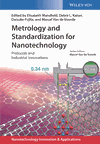Introduction: An Overview of Nanotechnolgy and Nanomaterial Standardization and Opportunities and Challenges
Abstract
This chapter examines the trajectory of nanotechnology standardization, and explains some of the broader trends relating to technology standardization as that can provide some additional context to understand and appreciate nanotechnology standardization. As nanotechnology and nanomaterials are increasingly being used in commercial applications, nanotechnology-related standardization is helping by developing common vocabularies and terminologies and by providing standardized testing techniques that can inform important decisions about potential risks relating to these materials. International Electrotechnical Commission (IEC) Technical Committee 113 (TC113) standardization work leverages expertise from 14 participating countries and includes 13 specifications, standards, and technical reports that cover test methods for measurement and characterization of electrical and electronic properties of various nano-objects and specifications to assist in different aspects of nanomanufacturing. Another international organization that is playing an important role in developing protocols and specifications for measurement and characterization of nanomaterials is the Organization for Economic Cooperation and Development's Working Party on Manufactured Nanomaterials (OECD WPMN).



